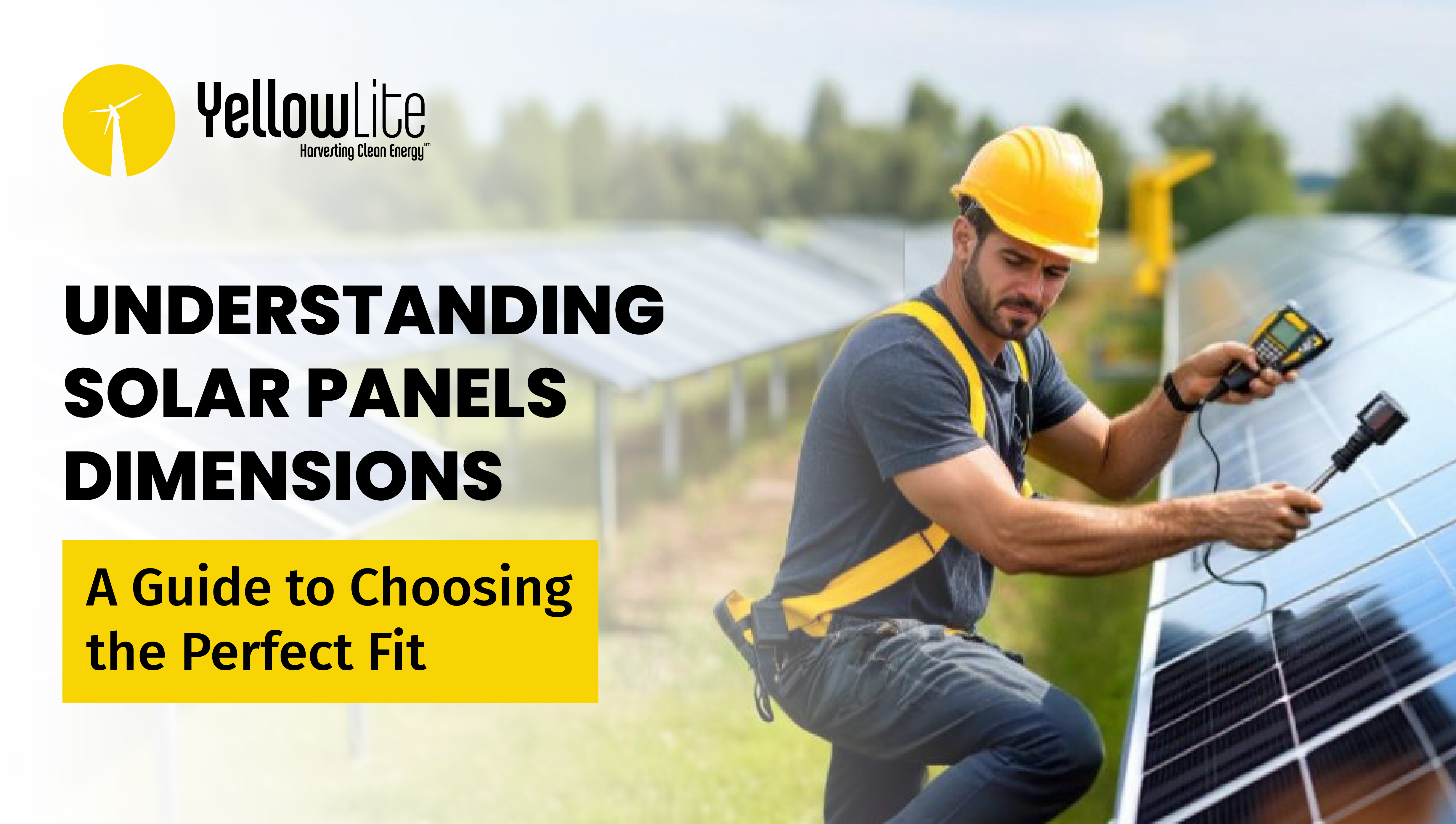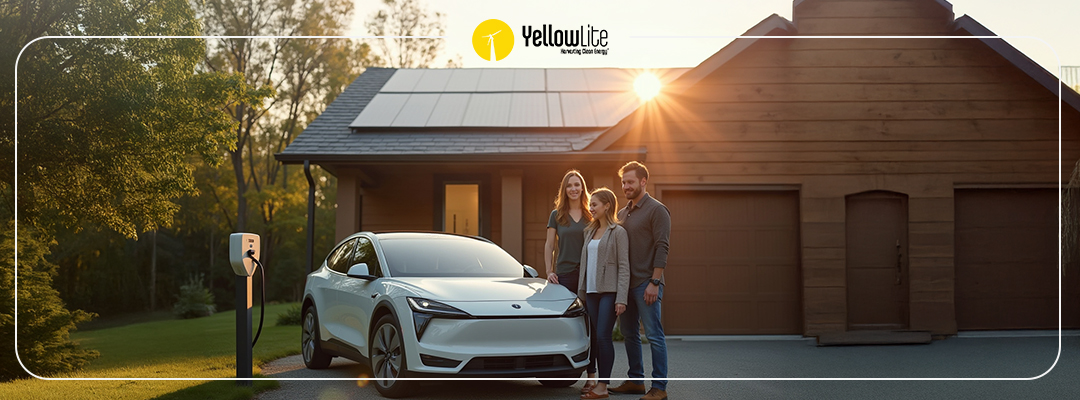Selecting the right solar panels dimensions can feel overwhelming. With various panel sizes, wattages, and installation requirements, homeowners and business owners often struggle to determine what fits their space while maximizing energy output.
Imagine investing in a solar system only to realize your roof doesn’t have enough space, or your chosen solar panels sizes don’t generate enough power to meet your needs. A mismatch between solar panels dimensions and your energy requirements could mean lower savings and suboptimal performance.
This guide will break down standard solar panels dimensions, explain how solar panels height weight impact efficiency, and help you in calculating solar panel size for your home or business.
Standard Solar Panels Dimensions
Residential vs. Commercial Solar Panels Sizes
The size of solar panels varies based on application. Residential solar panels sizes typically measure around 65 inches x 39 inches (5.4 ft x 3.25 ft) and have 60 solar cells, making them ideal for home rooftops. Commercial solar panels dimensions, on the other hand, are larger, usually 78 inches x 39 inches (6.5 ft x 3.25 ft) and contain 72 solar cells, allowing businesses to generate more power with fewer panels.
Common Solar Panels Height, Weight
Most solar panels in Ohio weigh between 40-50 lbs, making them sturdy yet manageable for rooftop installations. Their slim profile (about 1.5 inches thick) ensures easy integration without adding excessive load to your roof.
How Solar Panels Dimensions Affect Power Output
When choosing solar panels sizes, you must be extra careful as it impacts energy production, efficiency, and long-term savings. The right solar panels dimensions can maximize power generation while ensuring optimal use of available space.
Wattage and Efficiency Based on Solar Panels Dimensions
The solar panels sizes directly impact its power output. Standard residential solar panels typically produce 300W to 400W per panel, while commercial panels can generate 400W to 500W or more due to their larger surface area. More solar cells mean higher wattage, but efficiency also depends on the panel type and sunlight exposure. Two major types of solar panels are primarily used.
Monocrystalline vs. Polycrystalline Solar Panels Sizes
- Monocrystalline panels are more efficient and compact, allowing them to produce higher wattage in a smaller footprint, ideal for Ohio homes with limited roof space.
- Polycrystalline panels are slightly larger for the same wattage but are more budget-friendly, making them suitable for larger installations where space is not a concern.
How to Calculate Solar Panel Size

Calculating solar panel size is crucial for maximizing efficiency and ensuring it meets your energy needs. At YellowLite, we follow a structured approach based on industry best practices and U.S. Department of Energy guidelines to help Ohio homeowners approximately calculate solar panels sizes. Here’s a step-by-step method to calculating solar panel size:
Steps to Calculating Solar Panel Size
- Determine Your Annual Energy Consumption – Find your yearly energy usage (in kWh) from your utility bill.
- Account for Energy Efficiency Improvements – Subtract kWh that can be saved through energy conservation and efficiency upgrades.
- Estimate System Size – Divide the adjusted annual kWh by 1,100 kWh per installed kW (this represents a system designed to provide 100% of your electricity).
- Adjust for Desired Solar Contribution – Multiply by the percentage of electricity you want to generate with solar (e.g., 80% or 100%).
- Convert to Watts – Multiply the result by 1,000 to get the system size in watts (W).
- Account for System Inefficiencies – Multiply by 1.2 to compensate for losses due to wiring, inverters, and other system inefficiencies.
- Determine the Number of Panels Needed – Divide the final number by the wattage of the panels you’re considering (e.g., 400W panels).
For example, let’s say a homeowner in Ohio uses 12,000 kWh annually and wants to cover 80% of their energy needs with solar:
|
Step |
Data |
Example Calculation |
|
1. Annual energy usage |
Total electricity consumed yearly (kWh) |
12,000 kWh |
|
2. Energy efficiency savings |
kWh reduced through energy upgrades |
1,000 kWh |
|
3. Adjusted usage |
Annual energy usage minus savings |
11,000 kWh |
|
4. Estimated system size |
Divide by 1,100 kWh per installed kW |
11,000 ÷ 1,100 = 10 kW |
|
5. Adjust for solar coverage |
Multiply by % of energy to be covered by solar (e.g., 80%) |
10 kW × 0.8 = 8 kW |
|
6. Convert to watts |
Multiply by 1,000 to get total system size in watts |
8 kW × 1,000 = 8,000 W |
|
7. Adjust for system inefficiencies |
Multiply by 1.2 to compensate for losses |
8,000 W × 1.2 = 9,600 W |
|
8. Determine the number of panels |
Divide by panel wattage (e.g., 400W panels) |
9,600 ÷ 400 = 24 panels |
By calculating solar panel size using the above steps, this homeowner would need a 9.6 kW solar system with 24 panels to cover 80% of their energy consumption efficiently.
How Much Space Do I Need for a Solar Panel System?
One of the key factors in determining how much solar energy you can generate is the available space on your roof or property. Whether installing solar panels on a farm, commercial property, or residential rooftop, proper spacing is essential for maximum efficiency and performance.
To calculate the required area for your solar panel system, multiply the number of panels by the dimensions of each panel (length × width). Then, multiply this value by 1.05 to account for spacing between panels. As a general rule, a solar system requires approximately 100 square feet per kilowatt (kW) of capacity.
|
Step |
Data |
Example Calculation |
|
1. Number of panels needed |
Based on calculating solar panel size above |
24 panels |
|
2. Average panel size |
65 inches × 39 inches |
17.6 sq. ft |
|
3. Total panel area |
24 panels × 17.6 sq. ft |
422.4 sq. ft |
|
4. Adjust for spacing |
Multiply by 1.05 |
422.4 × 1.05 = 443.5 sq. ft |
|
5. General space rule |
100 sq. ft per 1 kW of solar |
9.6 kW × 100 = 960 sq. ft |
Based on the example above, the homeowner would need approximately 960 square feet of roof or yard space to install a 9.6 kW solar system efficiently.
Space Planning for Solar Installations
When planning a solar installation in Ohio, homeowners need to consider their roof space, orientation, and shading. A typical residential solar panels dimensions are 65 inches by 39 inches (17.6 sq. ft per panel), and a 5 kW system (sufficient for many homes) generally requires around 500 square feet of roof space. South-facing roofs with minimal shading yield the best results, but east- and west-facing installations can also provide significant energy production. If roof space is limited, higher-efficiency panels can help maximize energy output in a smaller area.
Ground-Mounted vs. Roof-Mounted Systems
For homeowners or businesses with limited roof space or structural concerns, ground-mounted solar panels offer an excellent alternative. These systems require more open land but allow for optimal panel tilt and orientation, improving efficiency. They also make maintenance and cleaning easier. However, they require more upfront space and might need zoning approval. On the other hand, roof-mounted systems make efficient use of existing structures, reducing land usage and installation costs.
Choosing the Right Solar Panels Dimensions for Your Needs
While selecting the right solar panels dimensions, keep in mind these factors:
- Energy needs: Larger systems generate more electricity but require additional space.
- Available space: Homeowners with limited roof space may prefer high-efficiency monocrystalline panels to maximize output.
- Budget: While larger panels can reduce installation costs per watt, they might not be ideal if space is restricted.
Best Solar Panels Height Weight for Different Applications
- Residential homes: Standard 60-cell panels work best with roughly 3.25 ft x 5.5 ft solar panels dimensions, producing 300-400W per panel.
- Commercial buildings: 72-cell panels whose solar panels sizes are 3.25 ft x 6.5 ft are larger and generate 400-500W per panel, making them ideal for businesses with larger energy demands.
- Farms & off-grid systems: Larger panels maximize open land use, while battery storage can provide energy stability.
Installation Considerations and Mounting Options
When installing solar panels in Ohio, choosing the right mounting system is required for optimizing energy production and ensuring long-term durability. Factors such as roof angle, available space, budget, and maintenance needs influence the decision between fixed and adjustable mounting options.
Fixed vs. Adjustable Mounting Systems
Fixed mounts are common for residential installations due to their durability and low maintenance. They are set at an optimal tilt for year-round solar production, making them a cost-effective solution.
Adjustable or tracking systems can increase energy output by following the sun’s movement, which is particularly beneficial for Ohio’s changing seasons. These systems maximize efficiency but are more expensive and require regular maintenance to function optimally.
Solar Panels Height Weight Considerations for Roof Structures
Before installation, it’s important to assess the roof’s strength to ensure it can handle the added weight of solar panels. A typical panel weighs 40-50 lbs, and an average system adds 3-5 lbs per square foot. YellowLite’s experts conduct thorough solar panel installation inspections to determine if reinforcements or alternative mounting solutions are needed, ensuring a safe and reliable solar panel installation.
Conclusion
In summary, when planning your solar installation in Ohio, it’s important to consider factors like space requirements, panel size, mounting options, and roof strength. Whether opting for fixed or adjustable systems, selecting the right solution ensures long-term energy savings and optimal performance.
At YellowLite, we offer customized solar solutions designed to meet your unique needs. Our expert team assists you through every step, from system sizing to hassle-free installation and maintenance. Ready to make the switch to clean, renewable energy? Contact YellowLite today for a free consultation and take the first step towards energy independence!
FAQs: Understanding Solar Panels Dimensions
1. What are the standard solar panels sizes for residential and commercial use?
The solar panels sizes for residential use typically measure around 65 inches by 39 inches, while commercial solar panels sizes are larger, averaging 78 inches by 39 inches. Choosing the right size depends on energy needs, available space, and installation type.
2. How does solar panels height weight impact installation?
The solar panels height weight can affect roof structure, mounting requirements, and installation costs. Standard residential panels weigh 40-50 lbs, adding 3-5 lbs per square foot to a roof. Ground-mounted systems have fewer weight restrictions but require more space.
3. How do I calculate the right solar panel size for my energy needs?
Calculating solar panel size involves analyzing energy consumption, roof space, and panel efficiency. A general rule is that 1 kW of solar power requires around 100 sq. ft. of space. YellowLite’s experts can help determine the perfect fit for your property.
4. What factors influence the efficiency of different solar panels sizes?
Larger solar panels sizes often generate more power, but efficiency also depends on panel type (monocrystalline vs. polycrystalline), orientation, and shading conditions. High-efficiency panels can produce more energy in a smaller footprint.
5. Can I customize my solar panels dimensions based on my roof size?
Yes, solar panel systems can be designed to fit various roof layouts. If space is limited, you can opt for smaller, high-efficiency panels to maximize energy production. YellowLite provides custom solar solutions to optimize your setup.



